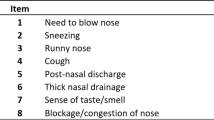Abstract
Our goal was to produce a reliable, responsive instrument to quantify disease burden in children with acute sinusitis for use in clinical trials. In a cross sectional survey of 1611 community pediatric patients, parents rated the burden attributable to 13 sinus symptoms. Using logistic regression, we identified five symptoms that predicted the clinical diagnosis of sinusitis. The S5 is the average symptom score for nasal obstruction, daytime and nighttime coughing, headache and colored nasal discharge (range 0–3). The S5 was high in children with acute sinusitis (mean = 1.54, SD = 0.77, N = 93), and low in well children (mean = 0.42, SD = 0.56, N = 1019). We assessed reliability and responsiveness of S5 in a prospective cohort study of 41 children with sinusitis. Parents completed a questionnaire at the office visit, at 12h and 3, 7, 10 and 14 days. Intra-subject reliability at 12 h was excellent (ICC=0.94). The S5 score was responsive in 24 patients followed for 14 days who improved (mean change = 1.52, SD = 0.12, p = 0.0062). The S5 score is standardized, reliable, responsive, easily obtained, and can be used to determine study eligibility and assess treatment effects without a physician's evaluation.
Similar content being viewed by others
References
McCaig LF, Hughes JM. Trends in antibiotic pre-scribing among offce based physicians in the United States. JAMA 1995; 273: 214±219.
Nyquist AC, Gonzales R, Steiner JF, Sande MA. An-tibiotic prescribing for children with colds, upper re-spiratory tract infections, and bronchitis. JAMA 1998; 279: 875±877.
Fireman P. Diagnosis of sinusitis in children: emphasis on the history and physical examination. J Allergy Clin Immunol 1992; 90: 433±436.
Kennedy DW, Gwaltney JM, Jones JG. Medical management of sinusitis: educational goals and man-agement guidelines. Annals Otol Rhin and Laryngol 1995; Suppl 167: 22±30.
Esposito AL. Role of oral antimicrobial drugs in the treatment of respiratory tract infections: overview and summary of newer agents. Infect Dis Clin Pract 1995; 4(4 Suppl): S250±S258.
Green M, Wald ER. Emerging resistance to antibiotics: impact on respiratory infections in the outpatient set-ting. Ann Allergy Asthma Immunol 1996; 77: 167±175.
Mafee MF. Modern imaging of paranasal sinuses and the role of limited sinus computerized tomography; considerations of time, cost and radiation. Ear, Nose and Throat Journal 1994; 73(8): 536±546.
Glasier CG. Incidental paranasal sinus abnormalities on CT of children. AJNR 1986; 7: 861±864.
Williams JW, Simel MD. Does this patient have si-nusitis? JAMA 1993; 270: 1242±1246.
O'Brien KL, Dowell SF, Schwartz B, Marcy SM, Phillips WR, Gerber MA. Acute sinusitis-Principles of judicious use of antimicrobial agents. Pediatrics 1998; 101(1 Suppl S): 174±177.
Wald ER, Chiponis D, Ledesma-Medina J. Compara-tive e.ectiveness of amoxicillin and amoxicillin-clavu-lanate potassium in acute sinus infections in children: a double-blind, placebo-controlled trial. Pediatrics 1986; 77: 795±800.
Shapiro GG, Rachelefsky GS. Introduction and de®-nition of sinusitis. J Allergy Clin Immunol 1992; 90: 417±418.
Rosenfeld RM. Pilot study of outcomes in pediatric rhinosinusitis. Arch Otolaryngol Head Neck Surg 1995; 121: 729±736.
Kirshner B, Guyatt G. A methodological framework for assessing health indices. J Chron Dis 1985; 38: 27±36.
Guyatt G, Walter S, Norman G. Measuring change over time: assessing the usefulness of evaluative instruments. J Chronic Dis 1987; 40: 171±178.
Deyo RA, Diehr P, Patrick DL. Reproducibility and responsiveness of health status measures. Controlled Clinical Trials 1991; 12: 1425±1585.
Bland JM, Altman DG. Statistical methods for as-sessing agreement between two methods of clinical measurement. Lancet 1986; 8476: 307±310.
Fleiss JL. Statistical Methods for Rates and Propor-tions, 2nd ed. 1981. New York: Wiley.
Author information
Authors and Affiliations
Rights and permissions
About this article
Cite this article
Garbutt, J.M., Gellman, E.F. & Littenberg, B. The development and validation of an instrument to assess acute sinus disease in children. Qual Life Res 8, 225–233 (1999). https://doi.org/10.1023/A:1008883508462
Issue Date:
DOI: https://doi.org/10.1023/A:1008883508462




